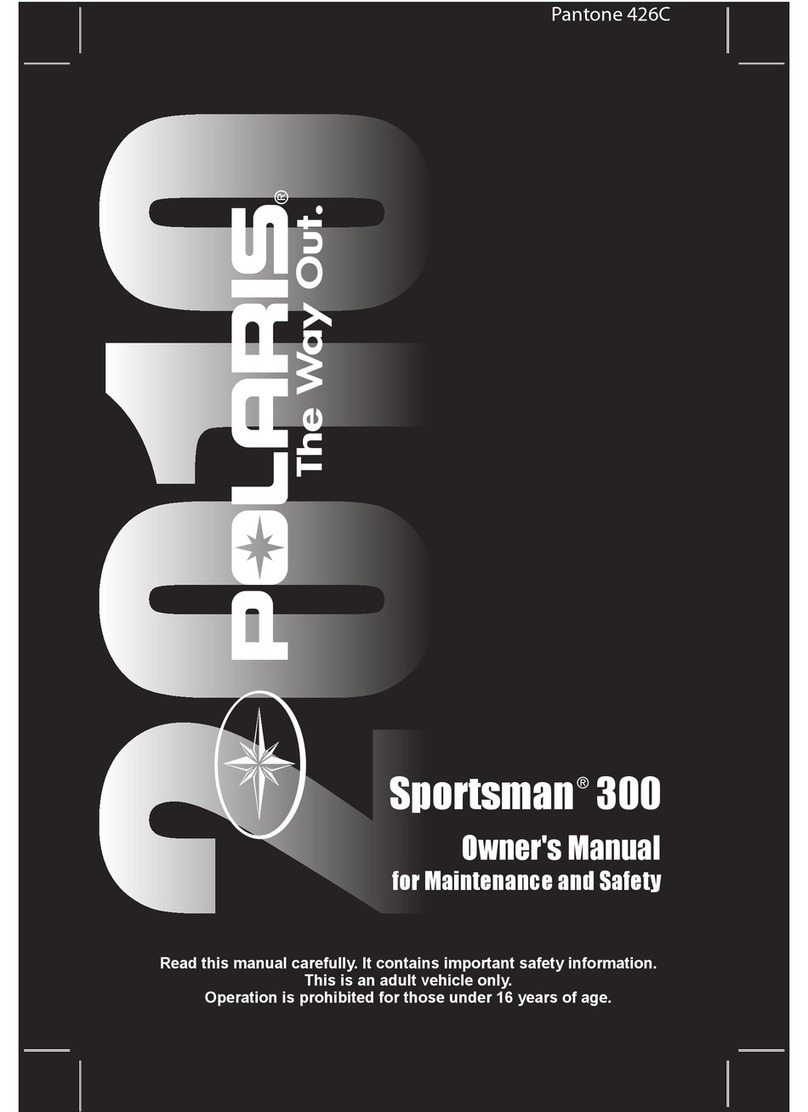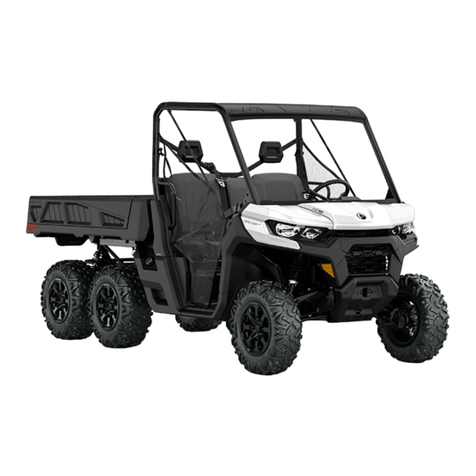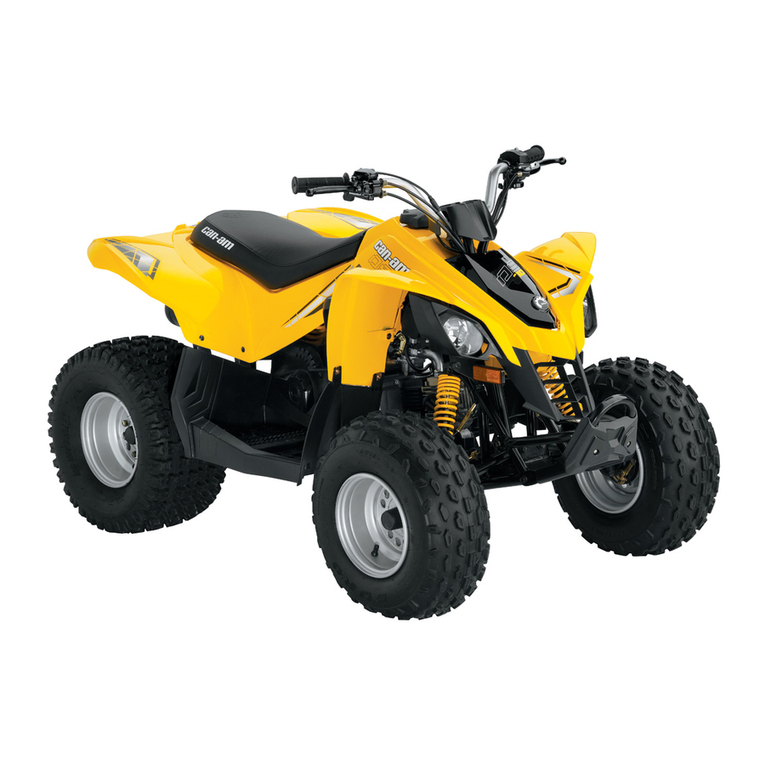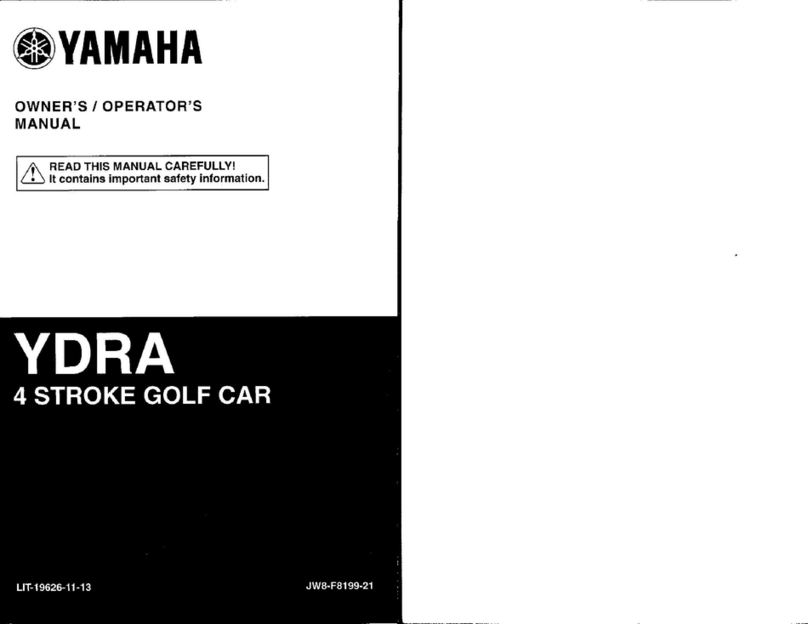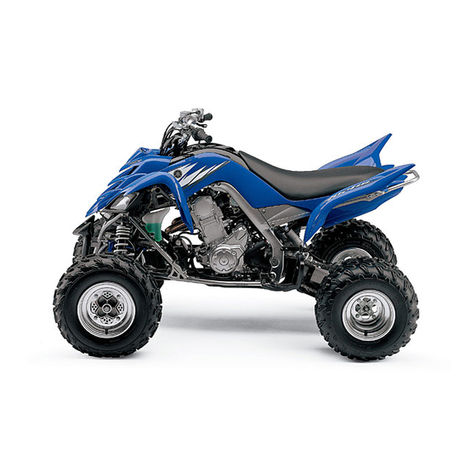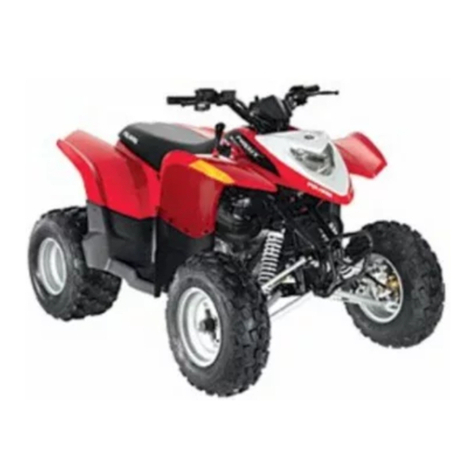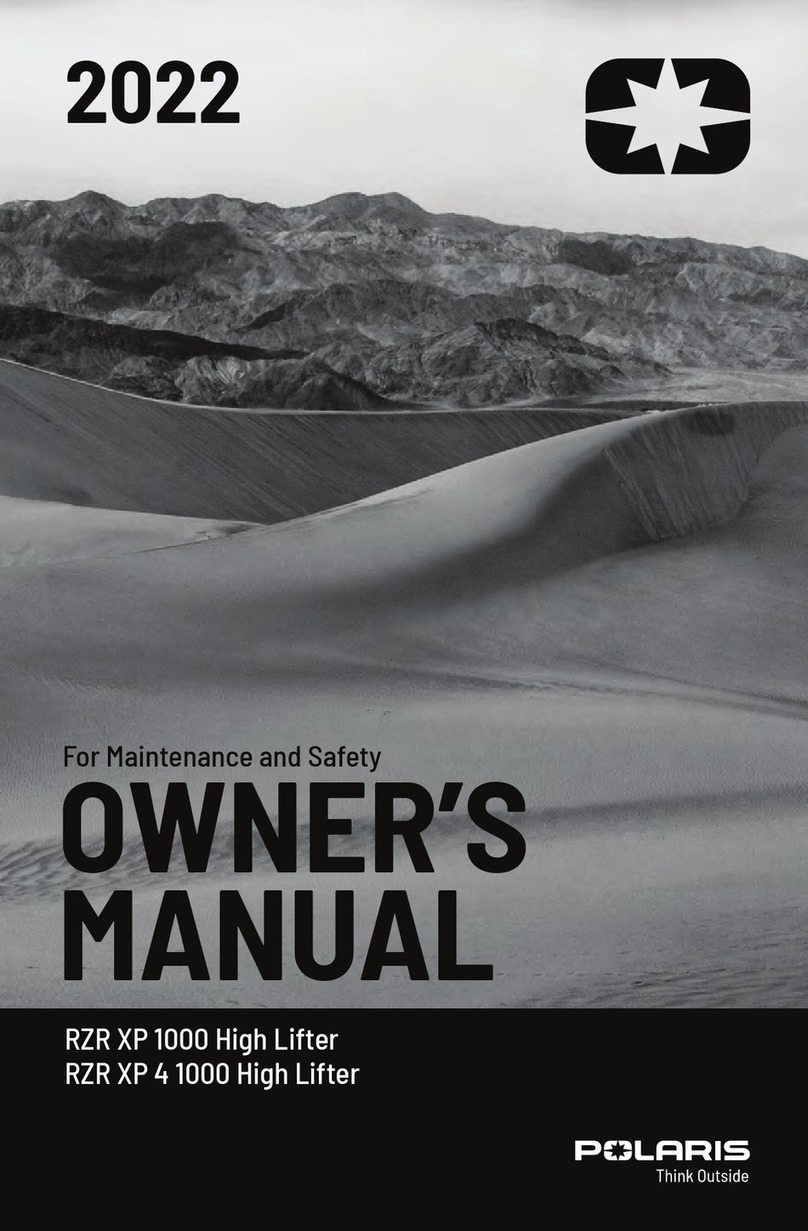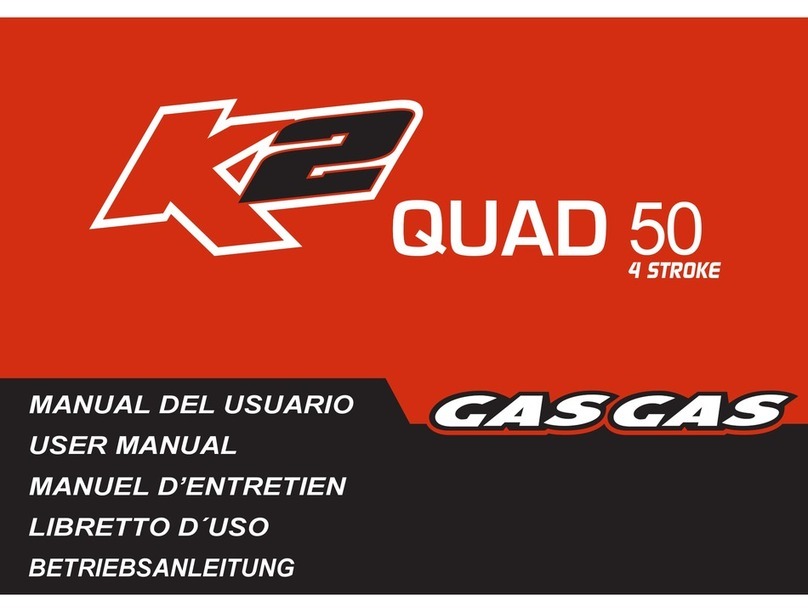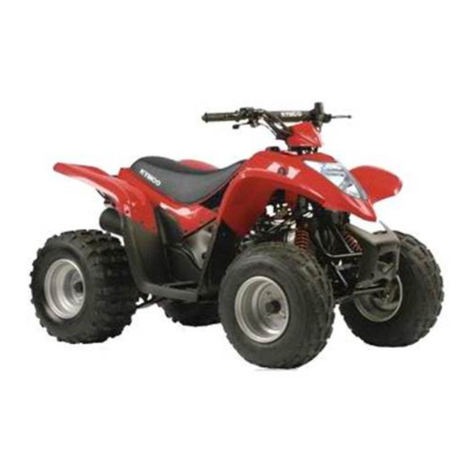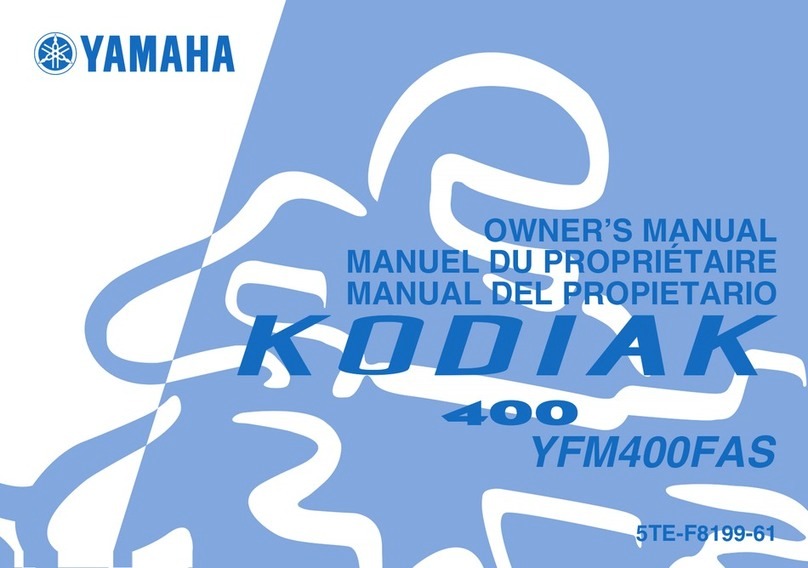Tracker LS2 2020 User manual

OWNER’S MANUAL
694652 - B

Read and comply with all of the instructions and safety precautions in this manual and on all product
labels.
Failure to follow the safety precautions could result in serious injury or death.
Never modify the vehicle in any way that will alter the weight distribution of the vehicle, decrease its sta-
bility or increase the speed beyond the factory specifications. Such modifications can cause serious per-
sonal injury or death. The manufacturer, prohibits and disclaims responsibility for any such modifications
or any other alteration which would adversely affect the safety of the vehicle.
The Engine Exhaust from this product contains chemicals known to the
State of California to cause cancer, birth defects or other reproductive harm.
WARNING
California Proposition 65

1
OWNER’S MANUAL
GASOLINE EFI
Starting MODEL YEAR 2020
MANUFACTURER INFORMATION
Textron Specialized Vehicles, Inc.
1451 Marvin Griffin Road
Augusta, Georgia, USA 30906-3852
Dealer: 800-296-4804
Consumer: 877-394-6727
www.trackeroffroad.com

2
WELCOME
Thank you for purchasing this vehicle. Before driving your new vehicle, read this owner’s manual to familiarize your-
self with safe driving practices, operation, features and controls.
This manual contains instructions for minor maintenance only. Information about major repairs can be found in the
repair manual. Your dealer has thorough knowledge of your vehicle and wants your total satisfaction with your pur-
chase. We recommend you return to your dealership for all of your service needs during, and after the warranty
period.
Repair or replacement parts can be purchased from your dealer or through the manufacturer’s parts and accessories
department.
These are original instructions as defined by 2006/42/EC.
The manufacturer maintains the right to change the design of the vehicle without responsibility to make the changes
on units purchased before changes were made. The information in this manual can change without notice.
All information in this owner’s manual is based on the latest product information at the time of publication. Due to con-
stant improvements in the design and quality of production components, some discrepancies may be found between
your vehicle and the information presented in this publication. The content in this publication is intended for reference
use only. The manufacturer is not liable for omissions or inaccuracies. Any reprinting or reuse of the content in this
publication, whether whole or in part, is expressly prohibited.
Issued Date: Feb 2019
Revised Date:
694652 - A
Printed in USA

TABLE OF CONTENTS
3
INTRODUCTION
MANUFACTURER’S INTENDED USE .....................................................................................................................7
WARRANTY AND REGISTRATION .........................................................................................................................7
EXHAUST EMISSIONS ............................................................................................................................................7
BATTERY PROLONGED STORAGE .......................................................................................................................8
BATTERY DISPOSAL ...............................................................................................................................................8
VEHICLE IDENTIFICATION NUMBERS .................................................................................................................8
REPAIR AND PARTS MANUALS .............................................................................................................................8
SAFETY LABELS
SAFETY LABELS ......................................................................................................................................................9
Operation ..........................................................................................................................................................9
Located on the steering wheel.Warning (P/N 625240) .....................................................................................9
Engine Warning (P/N 74093G01) .....................................................................................................................9
Governor Warning (P/N 608527) ....................................................................................................................10
SAFETY
MAXIMUM CARGO LOAD / MAXIMUM WEIGHT CAPACITY ...............................................................................11
TIRE PRESSURE ...................................................................................................................................................11
OPERATOR SAFETY .............................................................................................................................................12
Unauthorized Operation ..................................................................................................................................12
Operating without Instruction ..........................................................................................................................13
Alcohol or Drugs ..............................................................................................................................................13
Passenger .......................................................................................................................................................13
Before Operating .............................................................................................................................................13
Load Operation ...............................................................................................................................................13
Fuel Handling Guidelines ................................................................................................................................13
Carbon Monoxide Exposure ............................................................................................................................14
Driving in Reverse ...........................................................................................................................................14
Driving a Damaged Vehicle .............................................................................................................................14
Driving at Maximum Speeds ...........................................................................................................................14
Driving on Pavement .......................................................................................................................................14
Driving on Public Roads ..................................................................................................................................14
Turning ............................................................................................................................................................14
Driving Uphill ...................................................................................................................................................14
Driving Downhill ..............................................................................................................................................14
Stalling on a Hill ..............................................................................................................................................14
Tires ................................................................................................................................................................14
Slippery Terrain ...............................................................................................................................................15
HOT EXHAUST SYSTEMS .....................................................................................................................................15
VEHICLE LIFTING ..................................................................................................................................................15
VEHICLE MODIFICATION ......................................................................................................................................15
MAINTENANCE SAFETY .......................................................................................................................................15
FEATURES AND CONTROLS
Steering Wheel ................................................................................................................................................17
Brake Pedal .....................................................................................................................................................17
Park Brake ......................................................................................................................................................17
Accelerator Pedal ............................................................................................................................................17

4
TABLE OF CONTENTS
Horn .................................................................................................................................................................17
Cupholder ........................................................................................................................................................17
Key Switch / Light Switch (If Equipped with Lights) .........................................................................................17
Fuel Gauge with Low Oil Pressure Indicator ...................................................................................................18
Direction Selector ............................................................................................................................................18
Choke ..............................................................................................................................................................18
Fuse Block .......................................................................................................................................................18
Malfunction Indicator Light (MIL) .....................................................................................................................18
Hour Meter (if equipped) .................................................................................................................................18
Seat .................................................................................................................................................................19
Hip Restraints ..................................................................................................................................................19
Sweater Basket ...............................................................................................................................................19
Open basket (15) behind the seat back for carrying sweaters, jackets or small packages. ............................19
Bag Well ..........................................................................................................................................................19
Glove Box Compartments and Ball Holders ....................................................................................................19
Sun Top (If Equipped) .....................................................................................................................................19
Headlights / Turn Signals ................................................................................................................................19
Turn Signal Switch ..........................................................................................................................................19
Brake and Taillights .........................................................................................................................................19
OPERATION
SAFETY ..................................................................................................................................................................21
BEFORE INITIAL USE ............................................................................................................................................21
PRE-RIDE INSPECTION ........................................................................................................................................21
ENGINE BREAK-IN .................................................................................................................................................22
CVT BELT BREAK-IN .............................................................................................................................................22
FUEL .......................................................................................................................................................................22
ENVIRONMENTAL AWARENESS .........................................................................................................................23
STARTING AND STOPPING THE ENGINE ...........................................................................................................23
Starting on a Hill ..............................................................................................................................................23
ACCELERATING ....................................................................................................................................................24
BRAKING ................................................................................................................................................................24
DRIVING PROCEDURE .........................................................................................................................................24
Coasting ..........................................................................................................................................................24
DRIVING WITH A PASSENGER ............................................................................................................................24
SLIPPERY SURFACES ..........................................................................................................................................25
DRIVING UPHILL ....................................................................................................................................................25
TRAVERSING HILLSIDES ......................................................................................................................................25
DRIVING DOWNHILL .............................................................................................................................................25
STALLING ON A HILL .............................................................................................................................................26
DRIVING IN REVERSE ...........................................................................................................................................26
PARKING THE VEHICLE ........................................................................................................................................26
BATTERY ................................................................................................................................................................26
MAXIMUM LOAD DECK CAPACITY MAXIMUM WEIGHT CAPACITY .................................................................26
VEHICLE MAINTENANCE
MAINTENANCE SAFETY .......................................................................................................................................29
SCHEDULED MAINTENANCE ...............................................................................................................................29
Initial Service Requirements ............................................................................................................................29

TABLE OF CONTENTS
5
Severe Use Conditions ...................................................................................................................................29
SCHEDULED MAINTENANCE CHART ..................................................................................................................30
RECOMMENDED LUBRICANTS AND FLUIDS .....................................................................................................32
REPLACEMENT OF MAINTENANCE ITEMS ........................................................................................................32
LIFTING THE VEHICLE ..........................................................................................................................................33
Lifting Front ....................................................................................................................................................33
Lifting Rear ......................................................................................................................................................33
Lowering Vehicle .............................................................................................................................................33
VEHICLE CLEANING AND CARE ..........................................................................................................................34
Washing the Vehicle .......................................................................................................................................34
Polishing the Vehicle .......................................................................................................................................34
TIRES ......................................................................................................................................................................34
Tire Pressure ...................................................................................................................................................35
Tire Repair ......................................................................................................................................................35
Tire Replacement ............................................................................................................................................35
WHEELS .................................................................................................................................................................35
Wheel Removal ...............................................................................................................................................35
Wheel Installation ...........................................................................................................................................36
LIGHTS ...................................................................................................................................................................36
Headlight .........................................................................................................................................................36
Brake Light ......................................................................................................................................................37
FUSE REPLACEMENT ...........................................................................................................................................37
FOUR CYCLE ENGINE ..........................................................................................................................................37
Engine Specifications ......................................................................................................................................37
CHECK THE OIL LEVEL .........................................................................................................................................37
CHANGE THE ENGINE OIL ...................................................................................................................................38
Remove the Engine Oil ...................................................................................................................................38
Change the Oil Filter ......................................................................................................................................39
Refill Oil ...........................................................................................................................................................39
STARTER/GENERATOR BELT ..............................................................................................................................40
Adjusting the Belt ............................................................................................................................................40
AIR INTAKE AND COOLING FINS .........................................................................................................................40
REAR AXLE ............................................................................................................................................................41
Checking the Axle Oil Level ...........................................................................................................................41
AIR FILTER ............................................................................................................................................................41
LUBRICATION ........................................................................................................................................................41
MALFUNCTION INDICATOR LIGHT (MIL) .............................................................................................................42
SPARK PLUG ........................................................................................................................................................43
BRAKES ..................................................................................................................................................................44
Periodic Brake Test ........................................................................................................................................44
BATTERY ................................................................................................................................................................45
Battery Cleaning ..............................................................................................................................................45
Battery Charging .............................................................................................................................................45
Discharged Battery ..........................................................................................................................................46
Battery Disposal ..............................................................................................................................................46
Battery Storage ...............................................................................................................................................46
TRANSPORTING THE VEHICLE ...........................................................................................................................46
Hauling the Vehicle .........................................................................................................................................46

6
TABLE OF CONTENTS
Towing the Vehicle ..........................................................................................................................................47
VEHICLE STORAGE ..............................................................................................................................................47
Remove from Storage .....................................................................................................................................48
SPECIFICATIONS
TRACKER L4 - VEHICLE SPECIFICATIONS .........................................................................................................49

SAFETY
7
INTRODUCTION
The following symbols appear throughout this manual and on vehicle labels. Your safety is involved when these sym-
bols are used. Become familiar with their meanings before reading the manual.
DANGER indicatesahazardous situation that,if not avoided, will result in deathor seri-
ousinjury.
WARNING indicatesahazardous situation that,if not avoided, couldresult in deathor
seriousinjury.
CAUTION indicatesahazardous situation that,if not avoided, couldresult in minor or
moderateinjury.
The PROHIBITION SAFETY SIGN indicatesanaction NOTto take in ordertoavoidahazard.
The MANDATORYACTION SIGN indicatesanaction that NEEDStobe takentoavoidahazard.
Failureto complywiththe warningsinthis manual can result in severeinjuryor death.
Readthis entiremanual carefullybeforeoperatingthis vehicle. Do not attempt to operate
this vehicleuntil youhave thorough knowledge of the controls andfeatures.
Regular inspections andmaintenance, alongwithgoodoperatingtechniques,will help
ensureyour safeenjoyment of the capabilitiesandreliabilityof this vehicle.
This vehicle was designed and manufactured in the United States of America (USA). The standards and specifica-
tions in the following information originate in the USA unless otherwise indicated.
When servicing engines, all adjustments and replacement components must be per the original vehicle specifications
to maintain the USA Federal and State emission certification applicable at the time of manufacture.
MANUFACTURER’S INTENDEDUSE
This vehicle is designed and manufactured for off road use only. Use on public streets, roads, or highways is illegal in
most areas and increases the risk of an accident involving other vehicles and people. This vehicle does not meet
FMVSS (Federal Motor Vehicle Safety Standards) for public street, road, or highway use.
Check all laws and regulations before choosing an area to operate your vehicle.
WARRANTY ANDREGISTRATION
A literature package is included with the purchase of a new vehicle. The package contains the following items:
• Vehicle Warranty Statement
• EPA and California Emission Control Warranty Statement (EVAP emission)
• Emission Control System Warranty Statement (Engine emission)
• Vehicle Registration Card
Use Original Equipment Manufacturer (OEM) approved parts to keep the vehicle warranty effective.
Tampering with or adjusting the governor to allow the vehicle to operate above factory specifications will void the vehi-
cle warranty.
All information, including coverage, limitations, exclusions and how to obtain warranty service is included in the litera-
ture package with the purchase of the vehicle. It can also be obtained from an authorized dealer.
EXHAUSTEMISSIONS
The exhaust emissions of this vehicle’s engine complies with regulations set forth by the Environmental Protection
Agency (EPA) of the United States of America (USA) at time of manufacture. Significant fines could result from modi-
fications or tampering with the engine, fuel, ignition, or air intake systems. Refer to the warranty statements provided
with the vehicle for all information.

8
INTRODUCTION
BATTERYPROLONGEDSTORAGE
Batteries discharge over time. The rate of discharge changes according to the ambient temperature, the age, and con-
dition of the batteries.
Completely charged batteries will not freeze in winter temperatures unless the temperature is less than -75°F (- 60°C).
BATTERYDISPOSAL
Lead-acid batteries are recyclable. Return discarded batteries to distributor, manufacturer or lead smelter for recy-
cling. For neutralized spills, put any residue in acid-resistant containers with absorbent material such as sand. Dis-
pose in accordance with local, state and federal regulations for acid and lead compounds. Contact local or state
environmental authorized people for the disposal information.
VEHICLE IDENTIFICATION NUMBERS
Record the vehicle identification numbers in the spaces provided below. These identification numbers is required
when ordering parts from your authorized dealer.
Vehicle Model Number: _________________________________________________________________
Frame PIN: __________________________________________________________________________
REPAIR ANDPARTS MANUALS
The following manuals can be purchased through your authorized dealer:
• repair manual
• parts manual
V
PART B
PART C and D
PART A
PART C
Serial Number
Labels
PART D
V
PART A
PART B
PIN LABEL
PIN PLATE

SAFETY
9
SAFETY LABELS
SAFETY LABELS
Safety and warning labels are on the vehicle for your protection. Read carefully and comply with the instructions on
the labels. If any label shown in this manual is different from the label on your vehicle, always follow the instructions on
the vehicle label.
If a label comes off or becomes illegible, contact your dealer for a replacement. The part number is provided in this
manual, printed on the label, or can be obtained from your dealer.
Operation
Located on the steering wheel.Warning(P/N 625240)
Located on the front of the cup holder.
EngineWarning(P/N74093G01)
Located on the rear access cover.
664789
READANDOBEYTHE FOLLOWING WARNINGS TO
DECREASE RISK OFSEVERE INJURYOR DEATH.
BEFORE OPERATING
•READ the owner’s manual and all warning labels. Contact an authorized dealer or go to the manufacturer’s website for
replacement manual or labels. •This vehicle is equipped for personal use in most communities; however, state law or
local rules may require additional equipment in your community.
SAFE OPERATION & PARKING
•Turn key to ON, select Forward or Reverse, release the parking brake (if required), and slowly press
accelerator pedal. •Always bring vehicle to a complete stop before shifting the direction selector. •Always
remain seated in a moving vehicle. •Operate from the driver’s seat only. •Never drink alcohol or use
drugs or medications before or during operation of the vehicle. •ALWAYS engage the parking brake
and remove the key before leaving the vehicle. In an electric vehicle, put the direction selector in
OFF or Neutral; in a gasoline vehicle, put the selector in Forward.
MAINTENANCE & TOWING
•This vehicle requires regularly scheduled maintenance (see the
periodic service schedule in owner’s manual). •ONLY qualified
personnel should service this vehicle. •Vehicle is not
to be towed; consult owner’s manual for
transport instructions.
Pressing the accelerator pedal releases the parking brake even when the key is in the OFF position; the vehicle may
move when the accelerator pedal is pressed. Unintentional movement of the vehicle can cause injury or death. Do not
allow anyone to stand directly in front or behind the vehicle. •Driver must have a valid driver’s license. •Do not
operate vehicle until all occupants are properly seated with their backs against the seat and feet flat on the floor.
•Do not leave children unattended or allow them to play on a parked vehicle.
SAFETY INSTRUCTIONS
Operate from Driver’s side only.
Operation by persons with valid drivers license, in accordance with state requirements. For non-road use, and in designated areas only.
Maximum vehicle payload is 800 lbs. (363 kg) including a maximum of 2 persons, options, and accessories. Drive slowly
To release parking (PARK) brake, depress service (lower) brake pedal.
Before leaving vehicle, turn key ‘OFF’, move the direction selector to ‘forward’ (Gas vehicle) or ‘neutral’ (Electric vehicle) and engage
parking (PARK) brake.
All occupants must be fully seated, keep entire body inside vehicle and hold on while vehicle is in motion, move direction selector to desired position,
apply service brake, turn key to “ON” and accelerate smoothly.
release accelerator pedal and apply service brake.
625240
under the influence of drugs or alcohol. Do not operate
straight up and down slopes and in turns. Use care in reverse, in congested areas or wet or loose terrain. To stop,
WARNING Failureto followtheseinstructions can result in SERIOUS INJURYor DEATH
NEGATIVE
GROUND BATTERY
CLEAN GASOLINE SPILLS WITH WATER
BEFORE STARTING ENGINE
DO NOT SPILL FUEL ON
HOT ENGINE
NO TAMPERING
KEEP HANDS OUT
DO NOT EXPOSE
TO FLAME
GROUND
FUEL PUMP
SHORTING BATTERY TERMINALS
CAN CAUSE EXPLOSION

10
SAFETY
Governor Warning(P/N608527)
Located on the throttle-rod bracket.
DO NOT TAMPER WITH OR ATTEMPT TO CHANGE THE ADJUSTMENT OF THE
GOVERNOR. GOVERNOR TAMPERING CAN RESULT IN SERIOUS PERSONAL
INJURY AND WILL VOID THE VEHICLE WARRANTY.
608527

SAFETY
11
SAFETY
For questions about the vehicle or the material in this manual, see the contact information on page 1 or the back of
this publication.
Certain replacement parts can be used independently and/or in combination with other accessories to modify a manu-
factured vehicle to permit the vehicle to operate at or in excess of 20 mph. When a manufactured vehicle is modified
in any way by the Distributor, Dealer or customer to operate at or in excess of 20 mph on public streets or roads,
UNDER FEDERAL LAW the modified product will be a Low Speed Vehicle (LSV) subject to the strictures and require-
ments of Federal Motor Vehicle Safety Standard 571.500. In these instances, pursuant to Federal law the Distributor
or Dealer MUST equip the product with headlights, rear lights, turn signals, seat belts, top, horn and all other modifica-
tions for LSVs mandated in FMVSS 571.500, and affix a Vehicle Identification Number to the product in accordance
with the requirements of FMVSS 571.565. Pursuant to FMVSS 571.500, and in accordance with the State laws appli-
cable in the places of sale and use of the product, the Distributor, Dealer or customer modifying the vehicle also will be
the Final Vehicle Manufacturer for the LSV, and required to title or register the vehicle as mandated by State law.
Information on FMVSS 571.500 is found at Title 49 of the Code of Federal Regulations, section 571.500. For informa-
tion on-line, go to www.ecfr.gov.
The manufacturer will NOT approve Distributor, Dealer or customer changes that change a product into a Low Speed
Vehicle (LSV).
This vehicle meets the current applicable standard for safety and performance requirements.
MAXIMUM CARGO LOAD/MAXIMUM WEIGHT CAPACITY
Exceedingthe weightcapacitiescan causethe loss of vehiclecontrol andpossible
injuryor death.
• Do not exceed the maximum vehicle weight capacity (includes weight of operator, passenger, cargo, and accesso-
ries).
TIRE PRESSURE
Improper tirepressureor uneven tirepressurecan causethe loss of vehiclecontrol and
possibleinjuryor death.
Maintaining the correct tire inflation pressure is essential for safe vehicle operation. The inflation pressure can vary
within the recommended range to suit the condition of the terrain.
Maximum Vehicle Weight Capacity 800 lbs. (363 kg)
TIRE PRESSURE RANGE TERRAIN CONDITIONS RECOMMENDATION
18 - 22 psi (124 - 152 kPa)
Hard surfaces or pavement Inflate to higher pressure within the range; never exceed
maximum pressure indicated.
Soft terrain or turf Inflate to lower pressure within the range to reduce
potential damage to the terrain or turf.

12
SAFETY
OPERATOR SAFETY
Safe and responsible use of this vehicle is necessary to prevent dangerous conditions for the operator, passengers,
and other people in the area of operation. This section of the manual provides information on the safe operation of the
vehicle. Make sure to read, understand, and comply with all of this information to decrease the risk of personal injury
or death.
Seriousinjuryor deathcan occurifyoudo not followthe instructions andprocedures
showninthis owner’s manual.
• Read this entire manual and all product labels carefully. Follow the safety information and operating procedures
described.
• Operate your vehicle responsibly to prevent dangerous conditions for the operator, passengers and other people in
the area of operation
• Operate the vehicle responsibly and keep the vehicle in safe condition of operation.
• A damaged vehicle or a vehicle that is not functioning properly is dangerous and must not be operated until repairs
are made.
• Do not carry a passenger until you have a minimum of two hours driving experience on this vehicle.
• Keep feet, legs, hands, and arms inside the vehicle at all times.
• The driver must keep both hands on the steering wheel and both feet on the floor or pedals.
• Inspect the vehicle before each use to make sure it is in safe operating condition. Perform the pre-ride inspection
described in this manual. See page 21.
• Always have the vehicle checked by an authorized dealer if it is involved in an accident.
• Always put the direction selector in forward (F) and engage the parking brake before you exit the vehicle.
• Remove the key from the key switch when the vehicle is not in use to prevent accidental starting, unauthorized use
by someone below the age of 16, or someone without a driver’s license and proper training.
• Drive the vehicle at appropriate speeds for the terrain and conditions. Be aware of environmental conditions that
change the terrain and your ability to control the vehicle.
• Do not drive on excessively steep hills. Evaluate the terrain before descending a hill. Drive slowly and deliberately.
Use the brake to limit speed and maintain control. Sudden braking or turning can cause the loss of vehicle control.
Drive straight down the hill. Do not drive across the hill.
• Operate only in approved areas. Follow all applicable safety rules for the area.
• Avoid driving on terrain that is too rough for your vehicle’s capabilities and your driving skills.
• Before you drive in the reverse direction, make sure the area behind the vehicle is clear. Accelerate slowly and
avoid making sharp turns.
• Make sure the direction selector is in the correct position before pressing the accelerator pedal.
• Decrease the speed before and during turns.
• Decrease the speed when driving on wet or slippery surfaces.
• Bring the vehicle to a complete stop before moving the direction selector.
• Do not exceed the cargo or vehicle weight capacities. Do not exceed the occupant capacity. See SPECIFICA-
TIONS on page 49 for the vehicle load and seat capacity.
• If there is a risk of lightning, leave the vehicle and look for a safe location to wait until the lightning has stopped.
Additional information about safety is included throughout this manual or can be obtained from your dealer.
Failureto operatethis vehicleas instructed can causecollision,loss of control,or roll-
overresultingin severeinjuryor death. Followall safetywarningsinthis section of the
owner’s manual.See the OPERATION section of the owner’s manual for operatingproce-
duresandadditional safetyinformation.
Unauthorized Operation
This vehicle is for adult use only. Any person below the age of 16 is not permitted to operate the vehi-
cle.
Any person who does not have a valid driver’s license is not permitted to operate the vehicle.
Any person who is below the height of 59 in. (150 cm) is not permitted to operate the vehicle.
Leaving the keys in the key switch allows unauthorized operation of the vehicle by someone under 16
years of age, an unlicensed driver, or someone who does not meet the height requirement. Always
remove the key from the key switch when the vehicle is not in operation.

SAFETY
13
Operatingwithout Instruction
Operation of this vehicle without proper instruction increases the risk of an accident. The operator
must understand how to operate the vehicle correctly in different situations and on different types of
terrain.
All operators must read, understand, and comply with the owner’s manual and all warning and instruc-
tion labels before operating the vehicle.
Alcohol or Drugs
Operation of the vehicle during or after consuming alcohol or drugs can adversely affect operator judg-
ment, reaction time, balance, and perception.
Never drink alcohol or use drugs or medications before or during operation of the vehicle.
Passenger
All passengers must be at least 59 in. (150 cm) tall. Passengers must be able to sit with their back against the seat,
and both feet on the floor.
For additional safety and operational information, see Driving with a Passenger on page 24.
BeforeOperating
Perform the PRE-RIDE INSPECTION on page 21 before each use to make sure the vehicle is in safe operating con-
dition. Failure to inspect and confirm that the vehicle is safe to operate increases the risk of an accident.
Follow all inspection and maintenance procedures and schedules described in this owner’s manual. See SCHED-
ULED MAINTENANCE on page 29.
LoadOperation
The weight of cargo and occupants affects vehicle operation. Carefully calculate how the vehicle is loaded and how to
safely operate it. Follow the instructions in this manual for loading guidelines and tire pressure.
Do not exceed weight capacities specified for your vehicle. Capacities are listed in Maximum Cargo Load / Maximum
Weight Capacity on page 11 of this manual. As passenger weight increases, cargo weight needs to be adjusted to
ensure the maximum vehicle weight capacity is not exceeded.
Tire pressure must be adjusted to accommodate the load being carried. See Tire Pressure on page 11 for pressure
specifications.
Verify tire pressure, and drive slowly and carefully to maintain control of the vehicle if driving under any of the following
conditions:
• passenger and/or cargo exceeds half the maximum weight capacity
• driving over obstacles
• towing
• climbing a hill
FuelHandlingGuidelines
Gasoline is flammable and can be explosive in some conditions. Use the following guidelines when handling fuel:
• Always use caution when handling gasoline.
• Refuel in a well-ventilated area.
• Turn off the engine before refueling.
• Use an approved gasoline container to store fuel.
• Remove portable gasoline containers from the vehicle and place on the ground before filling to prevent ignition
caused by electrical static discharge.
• Do not smoke or allow open flames or sparks in or near the area where refueling is done or where gasoline is
stored.
• Do not overfill the tank. Do not fill the tank neck.
• If any gasoline contacts skin, immediately wash with soap and water. If any gasoline gets on clothing, change
immediately.
For refueling procedure, refer to Fuel on page 22.

14
SAFETY
Carbon Monoxide Exposure
Carbon monoxide is an odorless gas that is formed as a natural part of the combustion of hydrocarbon fuels.
Carbon monoxide is poisonous, and can cause loss of consciousness or death in a short period of time. Never start
the engine or allow it to run in an enclosed area.
If you experience any of the following symptoms, stop the engine and get fresh air immediately:
Operate this vehicle outdoors or in well-ventilated areas only.
Drivingin Reverse
Make sure the area behind the vehicle is clear before operating in reverse. After making sure it is clear and safe to
operate in reverse, accelerate slowly. Avoid making sharp turns in reverse. Refer to Driving in Reverse on page 26 for
operational information.
DrivingaDamaged Vehicle
Driving a damaged vehicle is not safe.
If the vehicle has been involved in any type of accident, have it inspected by a qualified service dealer to verify that it
is safe for operation.
Drivingat Maximum Speeds
Maximum speed operation increases the risk of loss of control. Always drive at a speed that is appropriate for the ter-
rain, visibility, operating conditions, and your skill and experience level. Use the brake to control speed and maintain
control of the vehicle.
Drivingon Pavement
Driving the vehicle on paved surfaces can affect handling characteristics and increase tire wear.
If possible, avoid driving on paved surfaces. If unavoidable, drive slowly, travel short distances, and avoid sudden
turns or stops.
Drivingon PublicRoads
Driving this vehicle on public streets, roads or highways could result in a collision with another vehicle. Never drive this
vehicle on any public street, road, or highway, including dirt and gravel roads, unless they are designated for off road
use. Most areas prohibit the operation of this vehicle on public streets, roads, or highways and can result in traffic vio-
lations and fines.
Turning
Improper or careless turning can cause loss of traction, loss of control, accident, or rollover. Do not turn quickly or at
sharp angles. Do not turn at high speeds. Practice turning at slow speeds before attempting to turn at faster speeds.
DrivingUphill
Do not climb hills that are too steep for the vehicle or your driving abilities. Loss of vehicle control or rollover can result
from climbing hills incorrectly. Refer to Driving Uphill on page 25 for operational information.
DrivingDownhill
Inspect the terrain before descending a hill. Avoid driving across hills. Use the brake to limit speed and maintain con-
trol. Loss of vehicle control or rollover can result from driving downhill incorrectly. Refer to Driving Downhill on page 25
for operational information.
StallingonaHill
A rollover can result from stalling or rolling backward while climbing a hill. Drive uphill at a constant speed. See proce-
dure on page 26 for maintaining control of your vehicle if it stalls on a hill.
Tires
Operating the vehicle with the incorrect tires or with the incorrect or uneven tire pressure can cause loss of control or
an accident. Always use the size and type of tires specified for the vehicle. See Vehicle Specification for proper tire
type and size. Always maintain the correct tire pressures as specified in Tire Pressure on page 11.
• dizziness • vomiting
• intense headache • muscular twitching
• weakness and sleepiness • throbbing in temples

SAFETY
15
SlipperyTerrain
Driving on rough, wet, or loose terrain increases the risk of loss of traction or control and accident or rollover. Drive
slowly and use the correct turning procedures when operating on slippery surfaces.
Tires that have lost traction and then regain traction suddenly can cause loss of vehicle control or rollover.
Refer to Slippery Surfaces on page 25 for operational information.
HOTEXHAUSTSYSTEMS
Exhaust system components are very hot during and after use. To avoid burn injuries, do not touch hot exhaust sys-
tem components. Hot components can also cause a fire. Keep combustible materials away from the exhaust system.
Check for buildup around the exhaust system after driving through high and dry grass.
VEHICLE LIFTING
The vehicle must be on a firm and level surface for lifting. Remain constantly aware that the vehicle is not stable
during the lifting process. Do not get under a vehicle until you verify that it is stable on the jack stands. Never get
under a vehicle while it is on a jack only. Put wheel chocks in front of and behind the wheels that are not being lifted.
Do not allow anyone to remain or get on the vehicle at any time during the lifting process.
Read and comply with all warnings and follow the lifting procedures described on page 33.
VEHICLE MODIFICATION
Do not install any accessory not approved by the manufacturer. Do not modify the vehicle to increase the speed or
power. Any modifications or installation of accessories not approved by the manufacturer can create a safety hazard
and increase the risk of injury.
The warranty will be terminated if the vehicle is modified to increase vehicle speed or power.
The warranty may be terminated if the original (or equivalent) replacement parts are not installed on the vehicle.
The addition of some accessories can change the handling characteristics of the vehicle. Use only approved accesso-
ries, and familiarize yourself with their function and effect on the vehicle.
MAINTENANCE SAFETY
Routine and scheduled maintenance of this vehicle is necessary to keep the vehicle in safe and reliable condition.
This section of the manual provides safety information for performing maintenance on your vehicle. Make sure to
read, understand, and comply with all of this information to decrease the risk of personal injury or death.
Seriousinjuryor deathcan occurifthe instructions andproceduresshowninthis
owner’s manual arenot followed.
• Read this entire manual and all product labels carefully. Follow the procedures and comply with the safety informa-
tion in this manual while performing vehicle service or maintenance.
• Use the tools shown in the tool list and wear the specified safety equipment when performing vehicle service or
maintenance.
• Remove all jewelry before servicing the vehicle.
• Do not allow loose clothing or hair to contact the moving parts.
• Do not touch hot objects.
• The drive wheels must be lifted and supported on jack stands before performing any service to the power-train
while the motor is in operation.
• Use wheel chocks and support the vehicle on jack stands. NEVER get under a vehicle that is supported by a jack.
Lift the vehicle following the instructions. See LIFTING THE VEHICLE on page 33.
•When servicing the vehicle, always wear eye protection. Be careful when working around batteries,
using solvents, or compressed air.
•Use insulated tools within the battery area to prevent sparks or battery explosion.
•To prevent the risk of battery explosion, keep all flammable materials, open flames or sparks away
from the battery.
• Hydrogen gas is produced as a battery is charged. Charge the battery only in well-ventilated areas.
• Maintain constant awareness that some components are heavy, spring loaded, corrosive, explosive, can cause
high amperage, or get extremely hot. Battery acid and hydrogen gas can cause bodily injury. Keep your hands,
face, feet, and body away from any area that can expose them to injury in the event that an unexpected situation
occurs.
• After making repairs or performing maintenance, test the vehicle in a safe area that is free from vehicle and person
traffic.

16
SAFETY

FEATURES AND CONTROLS
17
FEATURES AND CONTROLS
NOTICE: If the vehicle is equipped with factory installed custom accessories, some accessories remain oper-
ational with the key switch in the ‘OFF’ position.
SteeringWheel
The steering wheel (1) located in front of the driver seat is used
to steer the vehicle.
Brake Pedal
The brake pedal is located on the floor to the left of the accelera-
tor pedal (4). The brake pedal is a combination service brake (2)
and park brake (3). To activate the brake, press the lower part of
the pedal to slow or stop the vehicle.
ParkBrake
The foot operated park brake (3) is located along the top of the
brake pedal. To engage the park brake, push down on the upper
section of the pedal until it locks in place. The park brake will
release when the lower part of the brake pedal is pressed.
Accelerator Pedal
Unintentional movement of the accelerator pedal maycausethe vehicleto move which
couldresult in severeinjuryor death.
With the key switch in the ON position, pressing the accelerator pedal (4) starts the engine. When the pedal is
released, the motor will stop. To stop the vehicle more quickly, press the brake pedal.
Horn
The horn button (5) is located on the driver side floorboard. Pressing the button will sound the vehicle’s horn.
Cupholder
The vehicle has a center cup holder (6) that will accommodate four
beverage containers.
Key Switch/LightSwitch (If Equipped withLights)
Toreduce the possibilityof component damage, the vehiclemust be stopped before
movingthe key switch fromoneposition to another.
Located on the dash panel, the key switch (8) controls the basic electrical system of the vehicle. It also controls
optional front and rear lights.
The switch has either two or three positions:
• OFF and ON
• OFF and ON, and LIGHTS
To prevent inadvertent operation of the vehicle when left unattended, the key switch should be turned to the ‘OFF’
position and removed.
NOTICE: If the vehicle is equipped with factory installed custom accessories, some accessories remain oper-
ational with the key switch in the ‘OFF’ position.
1
2
354
6
8
7

18
FEATURES AND CONTROLS
FuelGauge withLowOil PressureIndicator
The fuel gauge (8) indicates the amount of gasoline in the fuel tank. ‘4/4’ indicates a full tank and ‘0’ indicates an
empty fuel tank. The fuel gauge has a low oil pressure indicator. A low engine oil pressure condition is shown with a
red indicator light.
The low oil pressure indicator light is located beside the fuel gauge on the dash, and not part of the fuel gauge.
Toprevent enginedamage, do not operatethe engine whenthe oil pressureindicator is
illuminated. Do not overfill the engine. Too much oil maycausesmokingor allowoil to
enterthe filterenclosure.
Direction Selector
Toreduce the possibilityof component damage,
the vehiclemust be completelystopped before
changingpositions of the direction selector.
Located on the seat wrap panel, the direction selector
lever (9) permits the selection of either ‘F’ (forward),
or ‘R’ (reverse). The vehicle should be left in ‘F’ when
unattended.
Choke
This vehicle is equipped with Electronic Fuel Injection and does not require a choke.
FuseBlock
The fuse block is used to provide electrical protection to some of the electrical components and vehicle accessories.
The fuse block is located under the seat on the front frame for the seat wrap.
Malfunction Indicator Light(MIL)
The MIL (11) is located under the seat and mounted to the
front of the seat wrap. Lift or remove the seat bottom to
view the MIL. The MIL can be used to diagnose a problem
and whether a technician will be required to service the
vehicle. See MALFUNCTION INDICATOR LIGHT (MIL) on
page 43.
HourMeter(if equipped)
The hour meter (12) is located under the seat and
mounted to the front of the seat wrap. The hour meter
shows the total run time for the life of the vehicle.
9
12
Front of Vehicle
11
Other manuals for LS2 2020
1
Table of contents
Other Tracker Offroad Vehicle manuals
